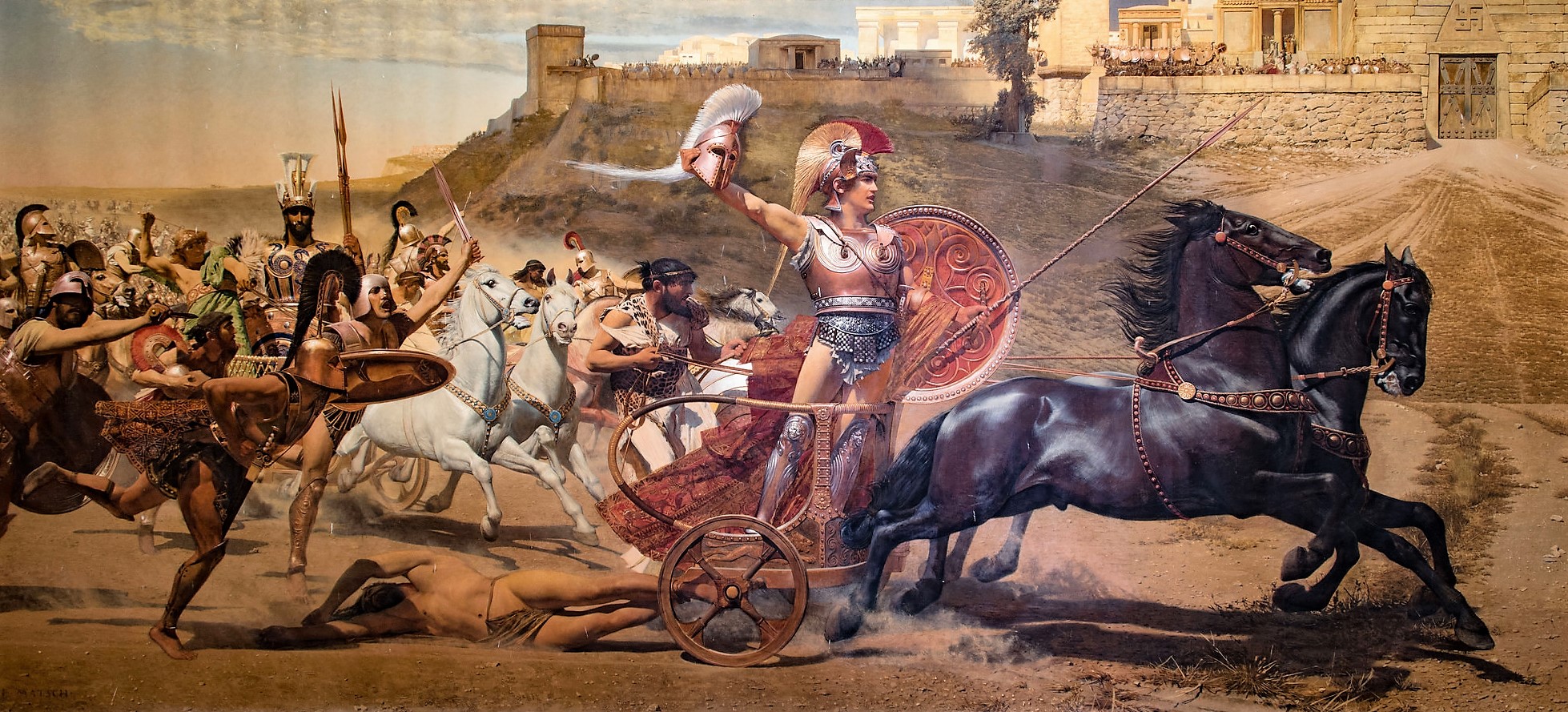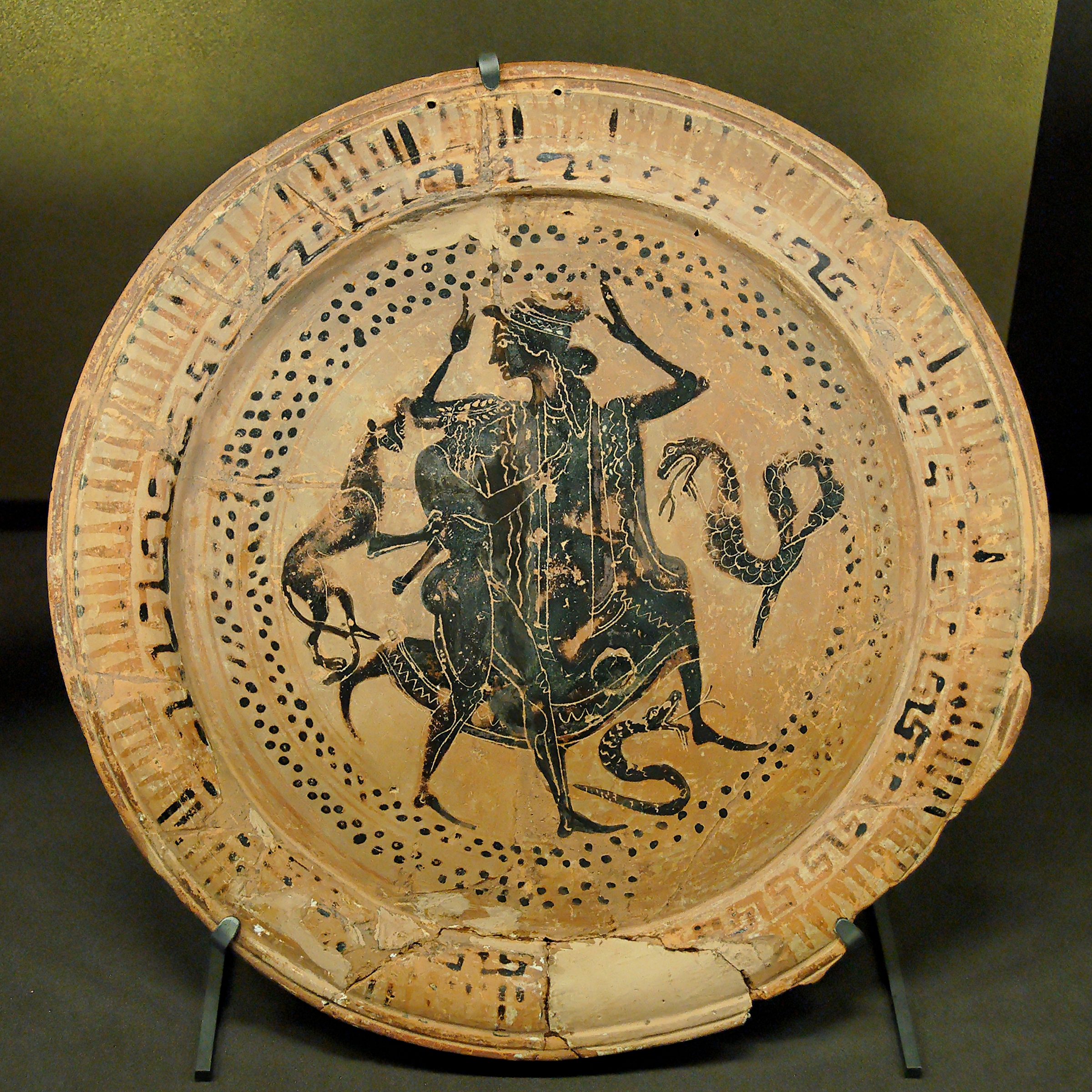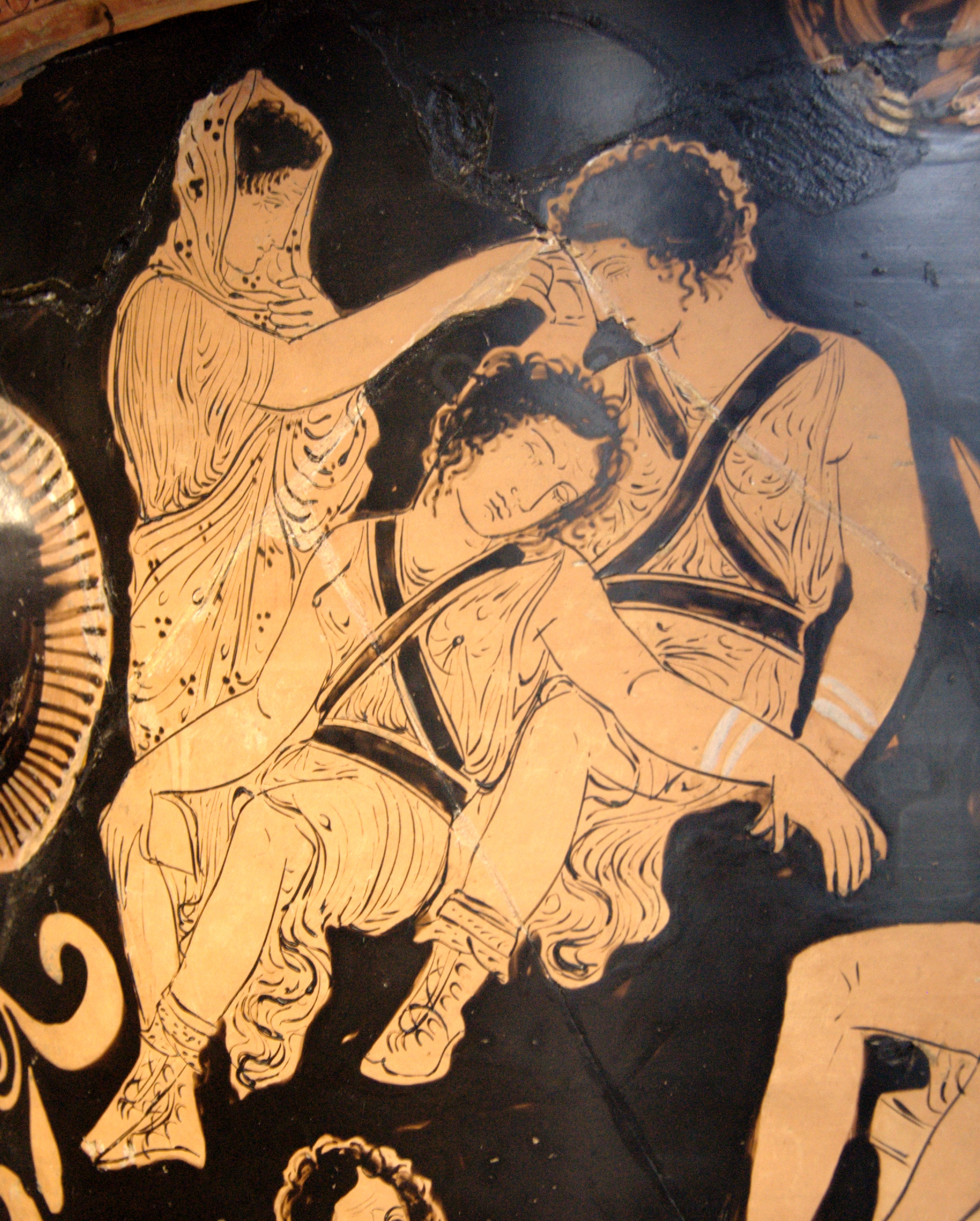|
Balius
Balius (; Ancient Greek: Βάλιος, ''Balios'', possibly "dappled") and Xanthus (; Ancient Greek: Ξάνθος, ''Xanthos'', "blonde") were, according to Greek mythology, two immortal horses, the offspring of the harpy Podarge and the West wind, Zephyrus. In other traditions, Poseidon is the father of Xanthus along with another horse named Cyllarus to an unnamed mother. It is possible that Xanthus's ability to speak prophetically may be related to Arion, another mythical horse reported to have saved Adrastus from the war of the Seven against Thebes with his prophetic abilities in Statius's ''Thebaid''. Mythology Poseidon gave the two horses to King Peleus of Phthia, as a wedding gift when Peleus married the Ocean goddess, Thetis. Peleus later gave the horses to his son Achilles who took them to draw his chariot during the Trojan War. Book 16 of the ''Iliad'' tells us that Achilles had a third horse, Pedasos (maybe "Jumper", maybe "Captive"), which was yoked as a trace ... [...More Info...] [...Related Items...] OR: [Wikipedia] [Google] [Baidu] |
Automedon
In Greek mythology, Automedon (; Ancient Greek: Αὐτομέδων), son of Diores, was Achilles' charioteer, who drove the immortal horses Balius and Xanthos. He was born on the island of Skyros. Mythology In Homer's ''Iliad'', Automedon rides into battle once Patroclus dons Achilles's armor, commanding Achilles' horses Balius and Xanthos. After Patroclus dies, Automedon is driven to the rear of the battle, where he tries to console the bereaved horses. Zeus finally intervenes, and Automedon resumes driving the chariot, but cannot aid the Achaeans until Alcimedon agrees to be his driver. He repels an attempt on his life by Hector, Aeneas, Chromios, and Aretos, killing Aretos''The New Century Classical Handbook''; Catherine Avery, editor; Appleton-Century-Crofts, New York, 1962, p. 144: "Aretus...was slain by Achilles' charioteer, Automedon" and taking his armor in the process. He also appears in the ''Aeneid'' at line 477 of Book II, when the Greek forces break in ... [...More Info...] [...Related Items...] OR: [Wikipedia] [Google] [Baidu] |
Harpy
In Greek and Roman mythology, a harpy (plural harpies, , ; ) is a half-human and half-bird mythical creature, often believed to be a personification of storm winds. They feature in Homeric poems. Descriptions Harpies were generally depicted as birds with the heads of maidens, faces pale with hunger and long claws on their hands. Roman and Byzantine writers detailed their ugliness. Pottery art depicting the harpies featured beautiful women with wings. Ovid described them as human- vultures. Hesiod To Hesiod, they were imagined as fair-locked and winged maidens, who flew as fast as the wind: Aeschylus Even as early as the time of Aeschylus, harpies were thought to be ugly creatures with wings, and later writers carried their notions of the harpies so far as to represent them as most disgusting monsters. The Pythian priestess of Apollo compares the appearance of the Erinyes, chthonic goddesses of vengeance, with those of harpies in the following lines of The Eumenides: ... [...More Info...] [...Related Items...] OR: [Wikipedia] [Google] [Baidu] |
Zephyrus
In Greek mythology and religion, Zephyrus () (), also spelled in English as Zephyr (), is the god and personification of the West wind, one of the several wind gods, the Anemoi. The son of Eos (the goddess of the dawn) and Astraeus, Zephyrus is the most gentle and favourable of the winds, associated with flowers, springtime and even procreation. In myths, he is presented as the tender breeze, known for his unrequited love for the Spartan prince Hyacinthus. Alongside Boreas, the two are the most prominent wind gods with relatively limited roles in recorded mythology. Zephyrus, similarly to his brothers, received a cult during ancient times although his worship was minor compared to the Twelve Olympians. Still, traces of it are found in Classical Athens and surrounding regions and city-states, where it was usually joint with the cults of the other wind gods. His equivalent in Roman mythology is the god Favonius. Etymology The ancient Greek noun is the word for the wind that ... [...More Info...] [...Related Items...] OR: [Wikipedia] [Google] [Baidu] |
Iliad
The ''Iliad'' (; , ; ) is one of two major Ancient Greek epic poems attributed to Homer. It is one of the oldest extant works of literature still widely read by modern audiences. As with the ''Odyssey'', the poem is divided into 24 books and was written in dactylic hexameter. It contains 15,693 lines in its most widely accepted version. The ''Iliad'' is often regarded as the first substantial piece of Western literature, European literature and is a central part of the Epic Cycle. Set towards the end of the Trojan War, a ten-year siege of the city of Troy by a coalition of Mycenaean Greece, Mycenaean Greek states, the poem depicts significant events in the war's final weeks. In particular, it traces the anger () of Achilles, a celebrated warrior, from a fierce quarrel between him and King Agamemnon, to the death of the Trojan prince Hector.Homer, ''Iliad, Volume I, Books 1–12'', translated by A. T. Murray, revised by William F. Wyatt, Loeb Classical Library 170, Cambridge, ... [...More Info...] [...Related Items...] OR: [Wikipedia] [Google] [Baidu] |
Podarge
In Greek mythology, Podarge () is a harpy, a personification of a swift wind and mate of Zephyrus, the West Wind. She is the mother of Balius and Xanthus — two divine horses renowned for their swiftness and who were gifted to Achilles, running as fast as the wind. In the ''Iliad'', she is described by Homer as having taken horse form, and 'grazing in a meadow by the stream of Ocean'. Some classical authors also regard her as Zephyrus' wife. However as the rainbow goddess Iris is his other wife and sister of Podarge, there is confusion between the two. Stesichorus says the divine horses Phlogeus and Harpagos are the offspring of Podarge.''RE'', s.v. Podarge (1); Stesichorusfr. 1 Campbell Her other names are ''Podarkes'', ''Podarke-Aellopos'' and ''Podarces''. Sources * Homer. ''Iliad'' xvi, 148. * Hyginus. ''Fabulae'' Preface, Fabulae 14. * Quintus Smyrnaeus. ''Fall of Troy 3'' 743. * Stesichorus. ''Funeral Games of Pelias'' Fragment 178. * Nonnus. ''Dionysiaca 37'' 155. Not ... [...More Info...] [...Related Items...] OR: [Wikipedia] [Google] [Baidu] |
Thetis
Thetis ( , or ; ) is a figure from Greek mythology with varying mythological roles. She mainly appears as a sea nymph, a goddess of water, and one of the 50 Nereids, daughters of the ancient sea god Nereus. When described as a Nereid in Classical myths, Thetis was the daughter of Nereus and Doris (Oceanid), Doris, and a granddaughter of Tethys (mythology), Tethys with whom she sometimes shares characteristics. Often she seems to lead the Nereids as they attend to her tasks. Sometimes she also is identified with Metis (mythology), Metis. Some sources argue that she was one of the earliest of deities worshipped in Archaic Greece, the oral traditions and records of which are lost. Only one written record, a fragment, exists attesting to her worship and an early Alcman hymn exists that identifies Thetis as the creator deity, creator of the universe. Worship of Thetis as the goddess is documented to have persisted in some regions by historical writers, such as Pausanias (geograp ... [...More Info...] [...Related Items...] OR: [Wikipedia] [Google] [Baidu] |
Peleus
In Greek mythology, Peleus (; Ancient Greek: Πηλεύς ''Pēleus'') was a hero, king of Phthia, husband of Thetis and the father of their son Achilles. This myth was already known to the hearers of Homer in the late 8th century BC. Biography Peleus was the son of Aeacus, king of the island of Aegina, and Endeïs, the oread of Mount Pelion in Thessaly. He married the sea-nymph Thetis with whom he fathered Achilles. Polymele, a daughter of Peleus, was one of the possible mothers of Patroclus by Menoetius. Peleus and his brother Telamon were friends of Jason and both were counted as Argonauts. Though there were no further kings in Aegina, the kings of Epirus claimed descent from Peleus in the historic period. Mythology Peleus and his brother Telamon killed their half-brother Phocus, perhaps in a hunting accident and certainly in an unthinking moment, and fled Aegina to escape punishment. In Phthia, Peleus was purified by the city's ruler, Eurytion, and then marr ... [...More Info...] [...Related Items...] OR: [Wikipedia] [Google] [Baidu] |
Hera
In ancient Greek religion, Hera (; ; in Ionic Greek, Ionic and Homeric Greek) is the goddess of marriage, women, and family, and the protector of women during childbirth. In Greek mythology, she is queen of the twelve Olympians and Mount Olympus, sister and wife of Zeus, and daughter of the Titans Cronus and Rhea (mythology), Rhea. One of her defining characteristics in myth is her jealous and vengeful nature in dealing with any who offended her, especially Zeus's numerous adulterous lovers and illegitimate offspring. Her iconography usually presents her as a dignified, matronly figure, upright or enthroned, crowned with a ''polos'' or diadem, sometimes veiled as a married woman. She is the patron goddess of lawful marriage. She presides over weddings, blesses and legalises marital unions, and protects women from harm during childbirth. Her sacred animals include the Cattle, cow, cuckoo, and Peafowl, peacock. She is sometimes shown holding a pomegranate as an emblem of immort ... [...More Info...] [...Related Items...] OR: [Wikipedia] [Google] [Baidu] |
Patroclus
In Greek mythology, Patroclus (generally pronounced ; ) was a Greek hero of the Trojan War and an important character in Homer's ''Iliad''. Born in Opus, Patroclus was the son of the Argonaut Menoetius. When he was a child, he was exiled from his hometown and was adopted by Peleus, king of Phthia. There, he was raised alongside Peleus' son, Achilles, a childhood friend, who became a close wartime companion. When the tide of the war turned against the Achaeans, Patroclus, disguised as Achilles and defying his orders to retreat in time, led the Myrmidons in battle against the Trojans and was eventually killed by the Trojan prince, Hector. Enraged by Patroclus's death, Achilles ended his refusal to fight, resulting in significant Greek victories. Name The Latinized name Patroclus derives from the Ancient Greek ''Pátroklos'' (), meaning "glory of his father," from (''patḗr'', "father" stem ''pátr''-) and (''kléos'', "glory"). A variation of the name with the same component ... [...More Info...] [...Related Items...] OR: [Wikipedia] [Google] [Baidu] |
Triumphant Achilles In Achilleion Levelled
"Triumphant (Get 'Em)" is a song by American singer Mariah Carey, featuring rappers Rick Ross and Meek Mill. It was written by Carey, Jermaine Dupri, Bryan-Michael Cox, Ross, and Mill and produced by Carey, Dupri and Cox. The song was released as a standalone single on August 3, 2012 by Island Records. Carey stated the song was written when her then-husband, actor Nick Cannon, was hospitalized with acute kidney failure in 2012, and was also inspired by the death of singer, and her friend, Whitney Houston. The song is a mid tempo hip hop ballad that "mixes a soft beat with piano accompaniment." Its lyrics convey a message of self-worth and perseverance, with Carey urging listeners to "Reach for the stars / Be all that you are." The song received mixed reviews, with many saying the singer was overshadowed by the hip-hop duo, and should have had more presence on her comeback single. Two accompanying versions were released alongside the original, titled the "Pulse Club" and "Vintage ... [...More Info...] [...Related Items...] OR: [Wikipedia] [Google] [Baidu] |
Erinyes
The Erinyes ( ; , ), also known as the Eumenides (, the "Gracious ones"), are chthonic goddesses of vengeance in ancient Greek religion and mythology. A formulaic oath in the ''Iliad'' invokes them as "the Erinyes, that under earth take vengeance on men, whosoever hath sworn a false oath". Walter Burkert suggests that they are "an embodiment of the act of self-cursing contained in the oath". Their Roman counterparts are the Furies, also known as the Dirae. The Roman writer Maurus Servius Honoratus ( AD) wrote that they are called "Eumenides" in hell, "Furiae" on Earth, and "Dirae" in heaven. Erinyes are akin to some other Greek deities, called Poenai. According to Hesiod's '' Theogony'', when the Titan Cronus castrated his father, Uranus, and threw his genitalia into the sea, the Erinyes (along with the Giants and the Meliae) emerged from the drops of blood which fell on the Earth ( Gaia), while Aphrodite was born from the crests of sea foam. Apollodorus also re ... [...More Info...] [...Related Items...] OR: [Wikipedia] [Google] [Baidu] |






